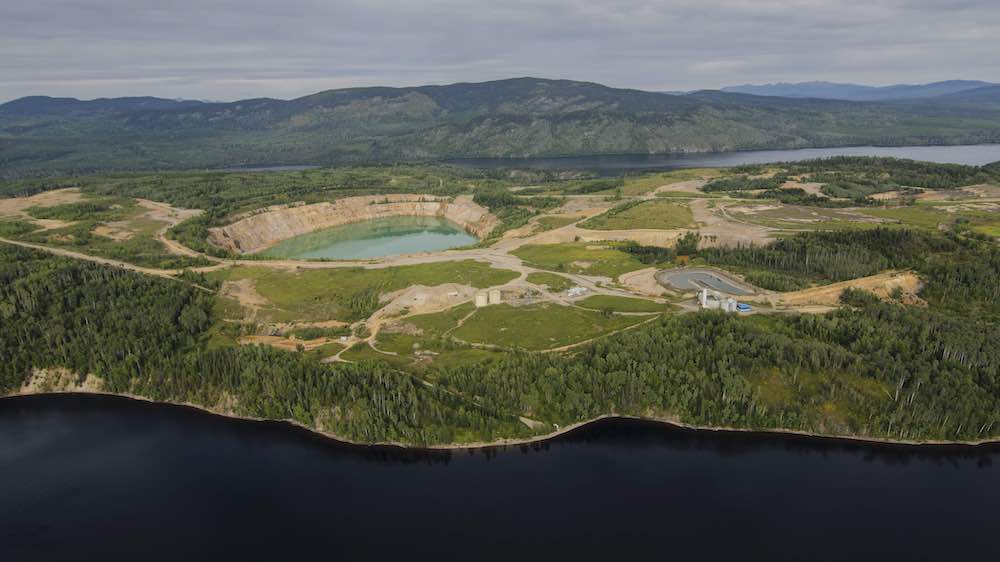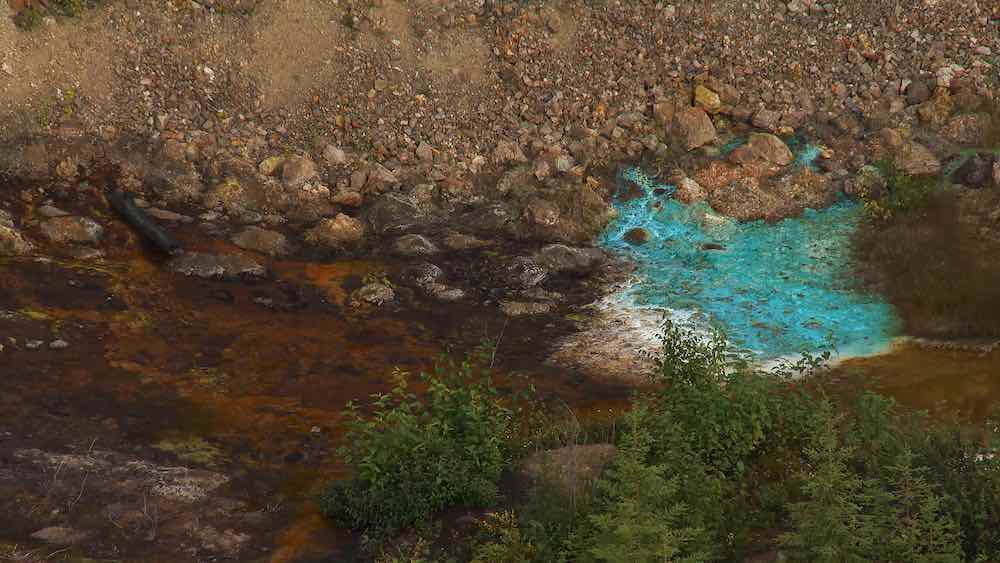Two closed mines on islands in Babine Lake are leaking dangerous levels of copper that could be damaging the Skeena watershed’s most valuable sockeye salmon spawning lake, The Tyee has learned.
In a report due out this week, SkeenaWild Conservation Trust and the Lake Babine Nation say an analysis of monitoring data from mine owner Glencore shows wastewater from the mines has included elevated levels of heavy metals, including copper contamination up to 20 times greater than provincial water quality guidelines.
It’s unclear what impact that could be having on Babine Lake’s salmon stocks, which account for 90 per cent of the Skeena watershed’s sockeye.
But Donna Macintyre, fisheries director for Lake Babine Nation, says there is clearly a threat.
“Does it affect salmon? Obviously, if we’re putting discharge into the lake, and we’ve got zooplankton that the fish depend upon for food, it will affect them,” Macintyre told The Tyee.
“We have these guidelines for copper, all of the heavy metals that are discharged into the lake, but they’re basically for human consumption. Nobody has really done major studies on fish.”
Alexis Segal, government relations and communications head for Glencore Canada, said the company’s aquatic monitoring programs show that environmental conditions in the lake have improved since the mines closed.
“Water quality in Babine Lake meets or is well below those water quality guidelines for all metals and other parameters,” Segal said in an email to The Tyee. Glencore monitors lake trout and sculpin because their entire life cycle occurs in the lake.
“Sockeye salmon migrate out of Babine Lake after the smolt stage of their life cycle and spend the majority of their life in the ocean. Because of this, it is impossible to evaluate potential influences on sockeye salmon related to their time in the ocean.”
Lake Babine Nation worked with SkeenaWild to analyze data that dates back to the mines’ operation in the 1970s. But the research focused on the past 12 years since the start of Glencore’s monitoring program at the sites. The studies were done on samples of water, sediment and tissue taken from lake trout and sculpin.
SkeenaWild executive director Greg Knox said the data show concerning levels of heavy metal contamination surrounding the mine sites. Monitoring of the sites for environmental impact is only taking place every five to 10 years, he said, too infrequently to protect the watershed.
Knox said the company is “mostly” keeping up with the monitoring required under its provincially issued permit.
But those requirements are inadequate, he said. “That’s the problem,” Knox said. “They’re not really required to do very much.”
And it’s a problem that goes far beyond the two mines at Babine Lake.
SkeenaWild and BC Mining Law Reform Network have completed a mapping project of operating and closed major coal and metal mines across the province.
It identified 173 mine sites and found 171 of them pose a threat to B.C.’s waterways.
There are known or potential leaks of contaminants from 116 of the mines. Another 55 have no publicly available information about contamination risks but are suspected sources of contamination given location and local geology, according to the organizations.
Acid mine drainage, a toxic substance that occurs when rock is exposed to air, is a concern at 71 of the sites.
“B.C. has a dirty mining problem that they don’t want the world to see,” Knox says. “If they really want to promote themselves as a clean mining jurisdiction, then they need to start cleaning up these sites, doing proper monitoring, and making sure that new mines that are being permitted have better mining practices.”

The Granisle and Bell mines are located on two islands in Babine Lake, the longest natural lake in the province. They began operating in the late 1960s and closed in 1982 and 1992 respectively.
According to Macintyre, who has worked with Lake Babine Nation’s fisheries department for nearly 30 years, they have always posed a concern to the nation’s members.
“When they see disturbances and great big, huge footprints in the land, such as these two mines, it’s my own opinion that we’re messing with Mother Nature,” she says. “Some people will often state that’s why people are getting ill, because we’ve scarred the land too much.”
In September, the nation signed a historic agreement with the federal and provincial governments to move forward on implementing the nation’s rights and title.
Macintyre would like to see fisheries protection and concerns about the mines incorporated into those discussions.
She says last year saw dramatically low numbers of salmon returning to the Babine’s tributaries, despite cool, wet weather that should have been favourable for salmon.
“The numbers returning, when we had our crews with their boots to the ground counting the number of spawners that returned to the individual streams that we count, was really low,” she says.
“But, obviously, when you look at copper, it affects the olfactory, their sense of smell, and the vibration, so they know where to go, when to leave, and how to come back to their natal spawning stream to spawn in the creek that they were born.”
Knox says that salmon numbers have seen “record low levels” in several years since 2013 and the mines could be a factor.
He adds that the company isn’t monitoring sockeye or studying juvenile salmon in the vicinity of the mine sites. As a result, direct impacts to salmon are unknown.

“We do know that the concentrations that are being found in the sculpin and lake trout are above levels that cause impacts to a fish’s smell, reproduction and predator avoidance,” he says, all of which could contribute to declining salmon returns in the Babine.
In a news release issued last week, the organizations flagged other mines of concern across the province. Among them is the closed Tulsequah Chief mine in the province’s far northwest, which has been leaking acid mine drainage into the Taku watershed for more than 60 years; Mount Polley mine, which has continued to affect water quality in Quesnel Lake since its tailings pond collapsed in 2014; Teck’s coal mines in the southeast, which have been polluting the Elk River, leading to the collapse of fish stocks; and Copper Mountain mine, which the groups say is discharging contaminated waste into the Similkameen River at a rate of 60 litres per second.
“In terms of mine waste and tailings facilities, I don’t think that our current Mines Act does enough to put safety first for both communities and watersheds, and that’s something that we want to see reformed,” says Nikki Skuce, co-chair of BC Mining Law Reform Network, a group of 30 organizations calling for reforms to provincial mining laws they say lack adequate enforcement and oversight provisions.
Skuce says the groups were motivated to create the map highlighting mine contamination because similar information hadn’t been released since the 1990s.
She adds the information isn’t easy to get from B.C.’s mining ministry.
“What some of the sites that we know show is that there’s discharge exceeding B.C.’s water-quality guidelines and yet there’s not much penalty or action. That doesn’t always trigger action or enforcement,” she said.
“Does that also mean that there’s no monitoring going on there? I think it’s concerning. If you don’t know what the problem is, you can’t take steps to address it.”
The Tyee reached out to the provincial government but has not received a response.
The map’s release coincided with the mining industry’s Remote Roundup conference, hosted in Vancouver by B.C.’s Association for Mineral Exploration. The event included a session about the trend to sustainable investing — known as ESG, or “environmental, social and governance” investing — and the need to promote B.C.’s mining industry as using “best practices.”
Skuce said that requires the province to make the safety of communities and watersheds a priority, as well as ensure that mining companies are prepared to cover the costs of mine cleanup or ongoing water quality problems.
“B.C. really wants to ground itself as a responsible mining jurisdiction and take advantage of the low-carbon economy,” she says.
“Yet British Columbians really value clean water, and I think that it is an issue with mining. We need to have greater transparency and do more to clean it up and reform our laws so that we’re not putting that at risk.”
*Story updated on Jan. 26 at 12:40 p.m. to add information from Glencore Canada received after publication. ![]()
Read more: Indigenous, Environment

















Tyee Commenting Guidelines
Comments that violate guidelines risk being deleted, and violations may result in a temporary or permanent user ban. Maintain the spirit of good conversation to stay in the discussion.
*Please note The Tyee is not a forum for spreading misinformation about COVID-19, denying its existence or minimizing its risk to public health.
Do:
Do not: